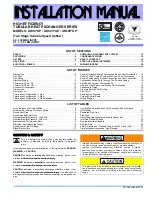
PRODUCT DESIGN
14
S
HOULD
OVERHEATING
OCCUR
OR
THE
GAS
SUPPLY
FAIL
TO
SHUT
OFF
,
TURN
OFF
THE
MANUAL
GAS
SHUTOFF
VALVE
EXTERNAL
TO
THE
FURNACE
BEFORE
TURNING
OFF
THE
ELECTRICAL
SUPPLY
.
WARNING
P
OSSIBLE
PROPERTY
DAMAGE
,
PERSONAL
INJURY
OR
DEATH
DUE
TO
FIRE
,
EXPLOSION
,
SMOKE
,
SOOT
,
CONDENSATION
,
ELECTRICAL
SHOCK
OR
CARBON
MONOXIDE
MAY
RESULT
FROM
IMPROPER
INSTALLATION
,
REPAIR
OPERATION
,
OR
MAINTENANCE
OF
THIS
PRODUCT
.
WARNING
Electrostatic Discharge (ESD) Precautions
NOTE:
Discharge your body’s static electricity before touch-
ing unit. An electrostatic discharge can adversely affect
electrical components.
Use the following precautions during furnace installation
and servicing to protect the integrated control module from
damage. By putting the furnace, the control, and the per-
son at the same electrostatic potential, these steps will
help avoid exposing the integrated control module to elec-
trostatic discharge. This procedure is applicable to both
installed and non-installed (ungrounded) furnaces.
1. Disconnect all power to the furnace. Do not touch
the integrated control module or any wire connected
to the control prior to discharging your body’s elec-
trostatic charge to ground.
2. Firmly touch a clean, unpainted, metal surface of the
furnaces near the control. Any tools held in a
person’s hand during grounding will be discharged.
3. Service integrated control module or connecting wir-
ing following the discharge process in step 2. Use
caution not to recharge your body with static elec-
tricity; (i.e., do not move or shuffle your feet, do
not touch ungrounded objects, etc.). If you come in
contact with an ungrounded object, repeat step 2 be-
fore touching control or wires.
4. Discharge your body to ground before removing a
new control from its container. Follow steps 1
through 3 if installing the control on a furnace. Re-
turn any old or new controls to their containers be-
fore touching any ungrounded object.
T
O
PREVENT
PROPERTY
DAMAGE
,
PERSONAL
INJURY
OR
DEATH
DUE
TO
FIRE
,
DO
NOT
INSTALL
THIS
FURNACE
IN
A
MOBILE
HOME
,
TRAILER
,
OR
RECREATIONAL
VEHICLE
.
WARNING
Introduction
This is a Category lV furnace. This furnace uses a pressur-
ized venting system and must be installed per National and
local codes requirements and the installation manual that
was shipped with the furnace.
Our 34.5" modulating furnace is one of the products in our
newly redesigned line of shorter chassis furnaces. It comes
in two models: an up flow / horizontal model and a down
flow / horizontal model.
The up flow / horizontal 34.5" modulating furnace is avail-
able in the following nominal capacities: 60,000 BTUH – 3
ton drive; 80,000 BTUH – 3 ton drive; 80,000 BTUH – 4 ton
drive; 100,000 BTUH – 5 ton drive; 120,000 BTUH – 5 ton
drive.
DM97MC0603BN**
DM97MC0803BN**
DM97MC0804CN**
DM97MC1005CN**
DM97MC1205DN**
The down flow / horizontal 34.5" modulating furnace is
available in the following nominal capacities: capacities:
60,000 BTUH – 3 ton drive; 80,000 BTUH – 3 ton drive;
80,000 BTUH – 4 ton drive; 100,000 BTUH – 5 ton drive.
DC97MC0603BN**
DC97MC0803BN**
DC97MC0804CN**
DC97MC1005CN**
Product Description
Features
General Information
The modulating furnace is part of our family of communi-
cating ready products. The furnace may be used with con-
ventional single or multi-stage thermostats as well as our
CTK01 communicating thermostats & CTK02**, CTK03 and
CTK04 communicating-modulating thermostats using the
ClimateTalk™ communicating protocol. Burner manifold
pressure is controlled by negative air pressure created by
the draft inducer. Gas valve, pressure switch assembly,
and induced draft blower are linked together by pneumatic
tubing. The furnace features a Honeywell gas valve ca-
pable of variable gas input rates as low as 35% and up to
100% of rated input. Indoor air is delivered by a variable
speed ECM motor which bases the CFM need off of the
burner input. The modulating furnace operation is based
off of negative pressure created by the draft inducer. The
Integrated Furnace Control (IFC) receives commands from
the room thermostat. The IFC then controls the RPM of the
(3 phase) inducer by varying the frequency and voltage to
the inducer. This is known as variable frequency drive (VFD).















































